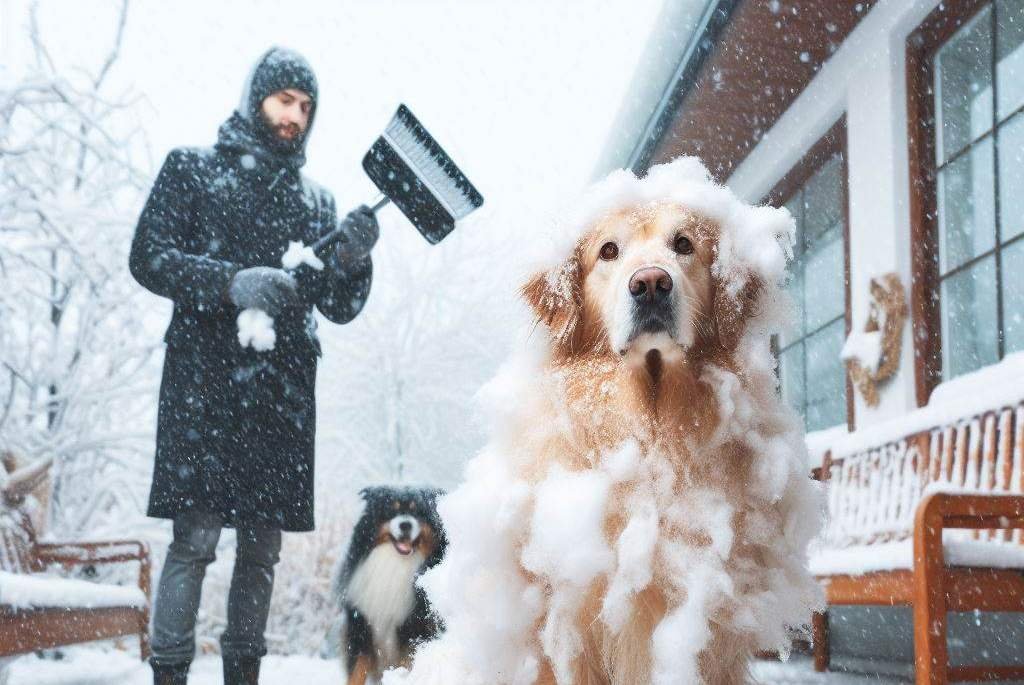Winter is often associated with cold weather, cozy sweaters, and snuggling up by the fireplace. However, for dog owners, winter can also bring about a significant increase in shedding. Many pet parents notice that their furry companions seem to shed more during the colder months, which can be surprising and even concerning. As winter sets in, many dog owners notice changes in their pet’s shedding patterns. While it may seem counterintuitive for dogs to shed more during the colder months, this phenomenon has several reasons. Everything can affect and influence shedding, from the breed of the dogs to their health condition, their diet to the climate condition. If you suspect any underlying health condition could be causing excess hair fall in your pet, you should consult Virginia Beach veterinary clinic.
In this context, we aim to provide you, as a dog owner, with a thorough understanding of the reasons behind increased shedding in dogs during winter. We also offer practical tips for managing and minimizing excessive shedding so you can help keep your furry companion comfortable and healthy throughout the colder months.
You’ll gain valuable insights into your dog’s natural shedding cycle as we analyze the various factors contributing to winter shedding, such as seasonal coat changes, indoor heating, and nutritional requirements. We’ll also discuss the importance of regular grooming and how you can effectively manage shedding by brushing your dog’s coat at least a few times a week.
Additionally, we’ll look into the role of nutrition in maintaining a healthy coat and minimizing shedding. Providing your dog with a balanced diet rich in essential nutrients can support their overall coat health and reduce excessive shedding during winter.
Throughout this content, we’ll highlight the importance of monitoring your dog’s shedding patterns and being aware of any sudden or severe increases in shedding, as this may indicate an underlying health issue. If you notice any concerning changes in your dog’s coat or shedding behavior, we encourage you to consult your veterinarian for proper guidance and treatment.
By the end of this content, we hope you’ll better understand why your dog may be shedding more during winter and feel empowered to take proactive steps to manage and minimize excessive shedding. Together, we can help ensure your furry friend stays comfortable, healthy, and happy throughout the colder season.
Reasons for Shedding in Dogs

- Seasonal Coat Changes: Like many animals, dogs have a natural shedding cycle that is influenced by changes in daylight and temperature. As winter approaches and daylight hours shorten, dogs instinctively prepare for the colder weather by shedding their summer coat and growing into thicker, warmer winter coats. This shedding process helps regulate their body temperature and protects them from the elements.
- Indoor Heating: While dogs may have evolved to adapt to seasonal changes, the prevalence of indoor heating in modern homes can disrupt their natural shedding cycle. Artificially warm environments can confuse a dog’s internal clock, causing them to continue shedding as if it were still summer. Additionally, dry indoor air can lead to dry skin, exacerbating shedding issues.
- Lack of Sunlight: The decrease in sunlight during winter can also affect a dog’s shedding patterns. Sunlight stimulates vitamin D production in a dog’s skin, essential for maintaining a healthy coat. With less sunlight, dogs may experience vitamin D deficiency, increasing shedding.
- Dietary Changes: Diet plays a significant role in the health of a dog’s coat. During the winter months, dogs may require additional nutrients to support the growth of their thicker winter coat if a dog’s diet lacks essential fatty acids, vitamins, and minerals.
- Stress and Anxiety: Stress and anxiety can manifest in various ways in dogs, including changes in behavior and coat condition. The colder weather, holiday festivities, and changes in routine associated with winter can all contribute to stress in dogs, leading to increased shedding. Providing your dog with a calm and stable environment during winter can help alleviate stress-related shedding.
- Lack of Grooming: With colder temperatures and inclement weather, dog owners may be less inclined to groom their pets regularly during winter. However, regular grooming is essential for maintaining a healthy coat and minimizing shedding. Brushing helps remove loose fur and distribute natural oils throughout the coat, preventing dryness and matting.
- Allergies: Like humans, dogs can experience seasonal allergies that may exacerbate shedding. Common allergens in the winter months include mold, dust mites, and indoor irritants like cleaning products and air fresheners. If your dog is experiencing excessive shedding alongside symptoms like itching, sneezing, or watery eyes, they may suffer from allergies. In this situation, it’s best to consult animal hospitals in Virginia Beach.
- Hormonal Changes: Hormonal fluctuations can also influence a dog’s shedding patterns. Female dogs may experience increased shedding during estrus (heat) cycles, while intact males may shed more due to fluctuations in testosterone levels. Additionally, senior dogs may undergo hormonal changes that affect their coat condition and shedding.
- Underlying Health Issues: In some cases, excessive shedding in dogs during winter may indicate an underlying health issue. Conditions such as thyroid imbalances, skin infections, and parasites can contribute to abnormal shedding patterns. If you notice a sudden or severe increase in shedding in your dog, it’s essential to consult with your veterinarian to rule out any underlying health concerns.
- Breed-Specific Factors: It’s essential to consider breed-specific factors when assessing a dog’s shedding patterns. Some breeds are naturally heavy shedders year-round, while others may have a seasonal shedding cycle that is more pronounced in winter. Understanding your dog’s breed characteristics can help you better manage their shedding and coat care needs.
Prevention Methods for Excessive Shedding

While dog shedding in winter is natural, excessive shedding can be frustrating for pet owners to manage. Fortunately, there are several steps you can take to help minimize shedding and keep your dog’s coat healthy and shiny throughout the colder months. We’ll explore some effective tips to prevent dog shedding in winter.
- Regular grooming is essential for managing dog shedding year-round, but it becomes especially important during winter. Brushing your dog’s coat regularly helps remove loose fur, distribute natural oils, and prevent matting. Use a high-quality brush or comb suitable for your dog’s coat type, and aim to groom them at least a few times a week.
- Provide a Balanced Diet: A balanced diet rich in essential nutrients is crucial for maintaining a healthy coat and minimizing shedding in dogs. During winter, consider feeding your dog a high-quality commercial dog food formulated to support coat health. Look for options containing omega-3 fatty acids, vitamins, and minerals that promote healthy skin and a shiny coat.
- Ensure Proper Hydration: Proper hydration is essential for maintaining healthy dog skin and coat. During the winter, indoor heating can lead to dry air, which may cause dehydration and exacerbate shedding. Ensure your dog has access to fresh, clean water at all times, and consider using a humidifier to add moisture to the air in your home.
- Limit Bathing: While regular grooming is essential, excessive bathing can strip your dog’s coat of its natural oils and contribute to dryness and shedding. During winter, limit bathing to when necessary and use a gentle, moisturizing dog shampoo formulated for sensitive skin. Be sure to thoroughly rinse your dog’s coat to remove all traces of shampoo, as residue can also contribute to shedding.
- Supplement with Omega-3 Fatty Acids: Omega-3 fatty acids are essential for maintaining healthy skin and coat in dogs. Adding a fish oil supplement to your dog’s diet can help reduce inflammation, improve skin hydration, and minimize shedding. Please consult with your veterinarian to determine the appropriate dosage for your dog based on size and individual needs.
- Control Indoor Environment: Controlling the indoor environment can help minimize shedding in dogs during winter. Keep your home clean and vacuumed regularly to remove loose fur and dander. Use a HEPA filter in your HVAC system to trap airborne allergens and minimize indoor irritants that can contribute to shedding. Additionally, provide your dog with a warm, comfortable bed away from drafts to help them maintain their body temperature and reduce stress.
Following these tips can help prevent excessive shedding in your dog during winter and keep their coat healthy and shiny. Remember to provide regular grooming, a balanced diet, proper hydration, and a comfortable indoor environment to support your dog’s overall wellbeing throughout the colder season. If you have any concerns about your dog’s shedding or coat condition, don’t hesitate to consult with your veterinarian for personalized advice and recommendations.
Additional info:

- Seasonal shedding:
- Many dog breeds have a natural shedding cycle that is influenced by changes in daylight and temperature.
- As winter approaches and daylight hours shorten, dogs instinctively shed their summer coat and grow thicker, warmer winter coats to regulate body temperature and protect them from the elements.
- Impact of indoor heating:
- Artificially warm environments created by indoor heating can disrupt a dog’s natural shedding cycle, causing them to continue shedding as if it were still summer.
- Dry indoor air can lead to dry skin, exacerbating dog shedding issues.
- Role of nutrition:
- A balanced diet rich in essential nutrients, such as omega-3 fatty acids, vitamins, and minerals, is crucial for maintaining a healthy coat and minimizing shedding in dogs.
- During winter, feeding your dog a high-quality commercial dog food formulated to support coat health can help reduce excessive shedding.
- Importance of regular grooming:
- Regular brushing helps remove loose fur, distribute natural oils, and prevent matting, mainly during winter when dogs may shed more.
- Using a high-quality brush or comb suitable for your dog’s coat type and grooming them at least a few times a week can help manage shedding effectively.
- Underlying health issues:
- In some cases, excessive shedding in dogs during winter may indicate an underlying health problem, such as thyroid imbalances, skin infections, or parasites.
- If you notice a sudden or severe increase in shedding, it’s essential to consult with your veterinarian to rule out any underlying health concerns and receive appropriate treatment.
FAQs:
Q: Is it normal for dogs to shed more during winter?
- A: It is usual for many dog breeds to shed more during winter as they prepare for the colder weather by shedding their summer coat and growing a thicker, warmer winter coat.
Q: Can indoor heating affect my dog’s shedding?
- A: Yes, indoor heating can create artificially warm environments that disrupt a dog’s natural shedding cycle, causing them to continue shedding as if it were still summer. Dry indoor air can also contribute to dry skin and increased shedding.
Q: How often should I groom my dog during winter to minimize shedding?
- A: Brushing your dog’s coat at least a few times a week during winter is recommended to remove loose fur, distribute natural oils, and prevent matting. The exact frequency may vary depending on your dog’s coat type and length.
Q: Can diet play a role in reducing excessive shedding in dogs during winter?
- A: Yes, providing your dog with a balanced diet rich in essential nutrients, such as omega-3 fatty acids, vitamins, and minerals, can help maintain a healthy coat and minimize shedding during winter.
Q: When should I be concerned about my dog’s excessive shedding during winter?
- A: If you notice a sudden or severe increase in shedding, accompanied by other symptoms like itching, skin irritation, or patches of hair loss.
Concluding Lines
While winter shedding may seem like an endless battle of fur, tumbleweeds, and sticky tape rollers, understanding the underlying reasons can help pet parents be patient and proactive. With extra attention to grooming, nutrition, and overall well-being, you can keep your dog’s coat healthy and under control during the colder months. Remember that shedding is simply part of your pup’s natural cycle and not necessarily a cause for concern. You and your furry companion can happily hunker down and weather the winter shedding season together by providing a little extra TLC and following veterinary guidance. So don’t despair when you see those tufts of fur accumulate – with some simple prevention measures, you can manage the winter coat blowout and enjoy the cozy season with your beloved dog.
